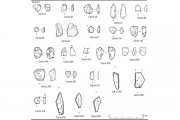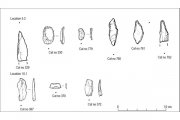Episode 2
Episode 2: The first farmers on Loch Lomondside
We left off the last part of the story around 6,000 years ago, with the Mesolithic hunter-gatherers experiencing a changing landscape around Loch Lomond, which had been inundated by the sea due to a rise in sea levels. However, by around 5,500 years ago, sea levels had fallen and the loch was once again freshwater.
The era from 6,000 to 4,500 years ago (4000 to 2500 BC) is widely referred to as the Neolithic period in Scotland, and is notable for the first evidence of farming practices, to at least supplement, if not take over from the earlier hunter-gatherer lifestyles. Archaeological evidence from this phase at Mid Ross suggested that people were more widely distributed across the area than before, and although the excavated features continued to be pits and hollows, changes in the remains and artefacts found in them seem to reflect this change in lifestyle.
Excavation at one location found not only a collection of pits, but also signs of activity beside a particularly prominent rock, which had likely been left behind by the retreating glaciers. Within the pits and beside the rock, archaeologists found sherds of characteristically Neolithic pottery – another new invention since the Mesolithic – which showed some signs of ‘carination’ (where a rounded base has been joined to inward-sloping sides). There were also remains of stone tools made of flint, quartz, chert and pitchstone, burnt hazelnut shells, and charcoal from a range of tree species including oak, hazel, willow, cherry and rose. Radiocarbon analysis dated these to around 5,950 to 5,660 years ago. Excitingly, however, some of the pits also included burnt cereal grains, including wheat and barley, suggesting that the Neolithic people at Mid Ross had indeed started to grow some crops, instead of relying solely on whatever they could forage from the woodland. Some possible stake or post holes within some of the pits suggested that some structures might have been erected there.
Growing crops has all sorts of possible wider implications, including the need to maybe clear trees to make space for them, as well as less need to travel around to look for natural seasonal food, and more need to stay put to look after the crops. Maybe these farming-style practices were also accompanied by changes in community structure, with more organisation and planning, as well as by a greater sense of ownership of the land?
Regarding the stone tools, as we noted earlier, flint isn’t locally available, and some tools were now also made of pitchstone, which comes from Arran. These finds suggest that people were travelling and trading over considerable distances, including by boat.
Excavation at another part of the site at the base of a slope also included pits and post holes, and signs of an ‘occupation hollow’. Again, they variously contained bits of pottery, stone tools (including pitchstone) and plant remains (including wheat, barley and spelt), as well as pieces of burnt bone (though it wasn’t clear if this was human or animal). Radiocarbon dates for this area were also around 5,910 to 5,650 years ago.
A further site near to the River Fruin was notable for the apparent occupation of hollows left by fallen trees (‘tree throws’), containing pottery sherds, stone tools, hazelnut shells and charcoal. Radiocarbon dating suggested that this area was also used around the same time as the other areas. Interestingly, the stone tool remains included flakes from a polished flint axe. Stone axes, as opposed to smaller stone tools, may be associated with the cutting down of larger trees to make space for cultivation.
Pits at a couple of other sites produced similar finds and dates.
Overall, the different types of charcoal found suggest that the shore of the loch around Mid Ross was mostly covered in mixed woodland (oak, hazel, willow, cherry, alder, birch and rose), similar to that seen in the Mesolithic. Groups of people continued to live here and use the natural resources, but also grew crops, and maybe cleared areas of land to do so. Maybe they also kept livestock, though there’s no evidence for that. Importantly, the presence of flint and pitchstone suggest that the people from Mid Ross either travelled or were visited by travellers from far afield.
It’s worth thinking a bit about what else is going on in the area around the same time as these finds at Mid Ross. A Neolithic chambered cairn on a hillside location at Cameron Home Farm is only about 3 km away from the sites at Mid Ross and would likely have been visible to the people living there. Maybe these were even some of the people who built it and visited it? As the name suggests, chambered cairns contained lots of separate chambers and the remains of several bodies, often with particular bits of multiple skeletons in different chambers, suggesting that people used to visit these cairns repeatedly over long periods of time to add or move the bones.
There are also some cup-marked stones in the area, as well as an assortment of stray finds, including a variety of stone tools and axeheads, all providing tantalising clues to the people living around the shores of the loch in the Neolithic period.
Episode 3 available here :)
Blog
Click on the link here to check out our Facebook page.
Events
Click here to find out about forthcoming events and how to get involved.
Timeline
Click here to see our timeline of events.
Location
Click here to find out where the Hidden Heritage Project is taking place.
Contact Us
Click here for our contact details.









